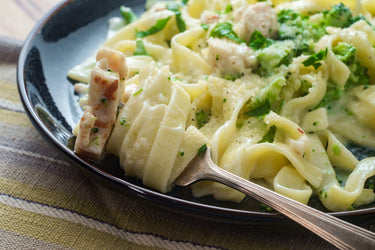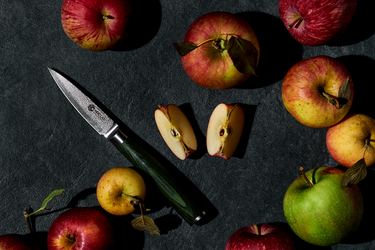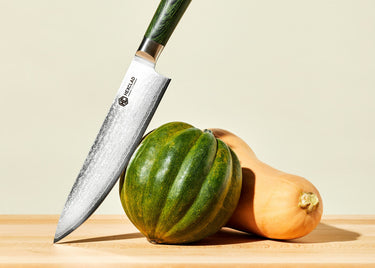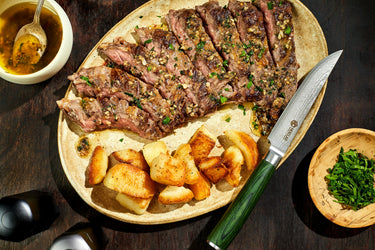A Brief History of Fettuccine Alfredo

Frequent any red sauce joint in the United States and you’re likely to see a very white sauce listed on the menu: fettuccine alfredo, often paired with chicken and called, naturally, chicken alfredo. The dish arrives, piled high with tangles of fettuccine noodles coated in a cream-based sauce. It is rich, nearly mac ‘n’ cheese adjacent, and perhaps for this reason, palatable to picky kids throughout the country. But despite Italians who might turn up their nose at the dish, calling it simply un-Italian, fettuccine alfredo has a centuries-long history that began in Rome.
In his book The Discovery of Pasta: A History in Ten Dishes, writer Luca Cesari traces the dish back to 1908, when Alfredo di Lelio—a restaurateur in Rome—made a simple fresh pasta with butter and parmesan cheese for his wife, Ines, who was struggling to recover after childbirth. The key was to use more butter than normal in a fettuccine al burro (fettuccine with butter). Alfredo began serving it at his restaurant, where he served it table-side, tossing the ribbonlike noodles with a hunk of Parmigiano-Reggiano carved from the center of the cheese wheel and a generous amount of butter.
According to Cesari, luck shone on Alfredo’s pasta, which he called fettuccine all’Alfredo. The dish received praise in Sinclair Lewis’s 1922 novel Babbitt, was the recipient of a glowing restaurant review in 1927 by well-known food expert and radio presenter George Rector (who published the recipe), and that same year, Hollywood stars Mary Pickford and Douglas Fairbanks gifted Alfredo with a golden fork and spoon engraved with the words “To Alfredo the King of Pasta.” Apparently, they’d eaten at Alfredo’s on their honeymoon in 1922 and fallen in love with the eponymous sauce. The extravagant gift garnered international press coverage, bringing Alfredo’s restaurant on Via della Scrofa and his pasta fame. During World War II, Alfredo sold his restaurant, eventually opening a new spot called Il Vero Alfredo—”the real Alfredo”—after the war ended. The name helped differentiate it from the original restaurant, where the owners fought to be known for the pasta.
Despite the international fame and its eventual copycats, fettuccine all’Alfredo never took off beyond Rome, perhaps contributing to its sense as an inauthentic dish in the eyes of many Italians. Cesari posits that this is perhaps because the method was so closely with its inventor (unlike the more anonymous styles of pasta like cacio e pepe, amatriciana, or carbonara). So, too, could the fact that the pasta featured parmesan (uncommon in Roman sauces) rather than pecorino, or that butter on noodles was seen as “hospital fare.”
Whatever the case, the world-renowned butter and parmesan dish never caught on in Italy, but did morph into a cream-based sauce that dominated in the United States. While the authentic rendition of Alfredo’s recipe was popular at first, eventually a sauce enriched with cream became standard. Eventually, the sauce was sold in jars and popularized by Olive Garden, where the now ubiquitous add-ins of shrimp and chicken were added. So, though they share a namesake, there is a long distance between the butter and parmesan sauce that slicked fresh, homemade noodles and a pile of mass-produced pasta tossed with a jar of creamy sauce and some chicken. That doesn’t mean that you can’t enjoy Chicken Alfredo, though. Done right, with high-quality ingredients, the dish is a sumptuous treat, perfect for winter nights.
Try your hand at the authentic Fettuccine all’Alfredo
In the recipe published for fettuccine all’Alfredo by George Rector in 1927, he described the recipe for the pasta as “a kilo of flour, five egg yolks, a glass of water and a pinch of salt,” going on to say that it’s about how Alfredo makes the pasta that sets it apart, giving the sense that it’s not possible to replicate the dish. That’s not to say that countless recipe writers haven’t tried. Todd Coleman published his own attempt at an authentic fettuccine all’Alfredo in Saveur, if you want to give it a try. Golden spoon and fork, optional.
How to make an American-style fettuccine alfredo that’s actually delicious
Just because it’s a bastardized version of the original, doesn’t mean that cream-based fettuccine Alfredo can’t be delicious. American versions will often include garlic, nutmeg, and/or parsley to the dish. J. Kenji López-Alt lightened up fettuccine Alfredo at Serious Eats, reducing the heavy cream to just 2 tablespoons and adding an egg and some cornstarch. Over at New York Times, you can find a recipe for fettuccine Alfredo that stays closer to its roots in those American red sauce joints, thick with cream and nary a green thing in sight.
If you want to make chicken alfredo at home, simply add some cooked chicken to the pasta, whether it’s rotisserie chicken or blackened chicken or some quickly grilled chicken.. Broccoli does well in the dish, too, since it cuts through the rich sauce.
Sources:
Cesari, Luca. The Discovery of Pasta: A History in Ten Dishes. Pegasus Books, 3 Jan. 2023.
Coleman, Todd. “The Real Alfredo.” Saveur, 13 Apr. 2009, www.saveur.com/article/Kitchen/The-Real-Alfredo/. Accessed 25 May 2023.
Mariani, John. “Why Fettuccine All’Alfredo Is One of the World’s Greatest Simplest Dishes.” Forbes, 21 Aug. 2021, www.forbes.com/sites/johnmariani/2021/08/10/why-fettuccine-allalfredo-is-one-of-the-worlds-greatest-simplest-dishes/. Accessed 25 May 2023.




